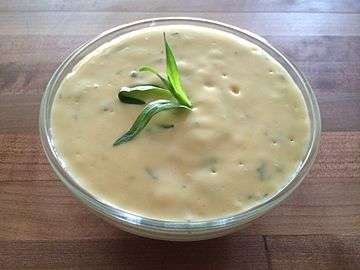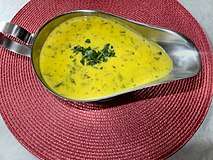Béarnaise sauce
Béarnaise sauce (/bərˈneɪz/; French: [be.aʁ.nɛz]) is a sauce made of clarified butter emulsified in egg yolks and white wine vinegar and flavored with herbs. It is considered to be a "child" of the mother Hollandaise sauce, one of the five mother sauces in the French haute cuisine repertoire.[1] The difference is only in the flavoring: Béarnaise uses shallot, chervil, peppercorns, and tarragon in a reduction of vinegar and wine, while Hollandaise is more stripped down, using a reduction of lemon juice or white wine. (One means of preparing Béarnaise, see below, is to start with Hollandaise and add the other ingredients.) Its name is related to the province of Béarn, France (see below).[2]
 Béarnaise sauce, garnished with tarragon. | |
| Type | Sauce |
|---|---|
| Place of origin | France |
| Main ingredients | Egg yolk, clarified butter, white wine vinegar |
In appearance, it is light yellow and opaque, smooth and creamy.
History
The sauce was accidentally invented by the chef Jean-Louis Françoise-Collinet, the accidental inventor of puffed potatoes (pommes de terre soufflées),[5] and served at the 1836 opening of Le Pavillon Henri IV, a restaurant at Saint-Germain-en-Laye, not far from Paris. This assumption is supported by the fact that the restaurant was in the former residence of Henry IV of France, a gourmet himself, who was from Béarn,[5][6] a former province now in the department of Pyrénées-Atlantiques, in southwestern France.
Preparation
Like Hollandaise sauce, there are several methods for the preparation of Béarnaise sauce. The most common preparation is a bain-marie method where a reduction of vinegar is used to acidulate the yolks. Escoffier[3] calls for a reduction of wine, vinegar, shallots, fresh chervil, fresh tarragon and crushed peppercorns (later strained out), with fresh tarragon and chervil to finish instead of lemon juice. Others are similar.[8] Alternatively, the flavorings may be added to a finished Hollandaise (without lemon juice). Joy of Cooking[9] describes a blender preparation with the same ingredients.
 Sauce Béarnaise
Sauce Béarnaise
Derivatives of Béarnaise sauce
- Sauce Choron or Sauce Béarnaise Tomatée is a variation of béarnaise without tarragon or chervil, plus added tomato purée.[9][10] It is named after Alexandre Étienne Choron.
- Sauce Foyot (a.k.a. Valois) is béarnaise with meat glaze (Glace de Viande) added.[9][11]
- Sauce Colbert is Sauce Foyot with the addition of reduced white wine.[12]
- Sauce Paloise is a version of béarnaise with mint substituted for tarragon.[13]
See also
References
- The family is sometimes referred to as "mayonnaise sauces" as they are, like mayonnaise, based on the emulsion of an oil in egg yolk.
- "Bernaise" is a frequent misspelling based on the common English pronunciation /bərˈneɪz/ (bər-NAYZ) of Béarnaise, not an attempt to associate the sauce with Bern, Switzerland, or any other location.
- Escoffier: 89
- Julia Child
- "What is Bearnaise sauce? | Cookthink". Archived from the original on 2009-06-02. Retrieved 2010-03-08.
- Restaurateur Fernand Point (1897–1955) in Ma Gastronomie.
- Cookwise, pp.304-5
- Joy of Cooking p.359
- Escoffier: 90
- Escoffier: 91
- Escoffier: 41
- Escoffier: 141
- Sources
- Child, Julia; Louisette Bertholle; Simone Beck (1961). Mastering the Art of French Cooking. New York: Knopf.
- Corriher, Shirley (1997). "Ch. 4: sauce sense". Cookwise, the Hows and Whys of Successful Cooking (1st ed.). New York: William Morrow & Company, Inc. ISBN 0688102298.
- David, Elizabeth (1960). French Provincial Cooking. Penguin. ISBN 978-0-14-118153-0.
- Escoffier, Auguste (1982) [Trans. fm 4th French (Flammarion) ed. 1921]. "Ch. 1: Sauces". La Guide Culinaire [The Complete Guide to the Art of Modern Cookery] (in French). English translation by H.L. Cracknell and R.J. Kaufmann (First American ed.). New York: Mayflower Books. ISBN 0-8317-5478-8.
- Rombauer, Irma S.; Rombauer Becker, Marion (1975). Joy of Cooking. New York: The Bobbs-Merrill Company, Inc. (MacMillan). ISBN 0-02-604570-2.
External links
| Wikibooks Cookbook has a recipe/module on |
| Wikimedia Commons has media related to Béarnaise sauce. |
| Look up béarnaise sauce in Wiktionary, the free dictionary. |
- Béarnaise sauce from the British Good Food TV channel